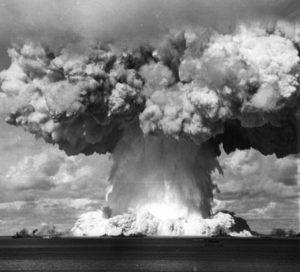Hydrogen. The most abundant and lightest element in the universe. Essential to life on earth as water. An important component of all organic compounds. Clearly, no matter if its atomic number is 1, hydrogen is certainly no inconsequential lightweight.
It’s true, it accounts for just 0.14% of the earth’s crust by weight, and its low density results in it being present in small quantities in the earth’s atmosphere. But, hydrogen covers almost three-fourths of the earth in the form of water. It is also present in countless carbon compounds in vegetable and animal matter and petroleum, and even accounts for two-thirds of the atoms that make up the human body. Coming back to the universe, hydrogen and helium together account for around 99.9% of all known matter in the universe. Hydrogen is the major component of all stars. During their lifetime, they keep fusing hydrogen into helium as they burn. Interestingly, while helium is classified as an unattractive, noble gas, hydrogen on the other hand is highly reactive, forming bonds with all kinds of elements.
Despite being produced for several decades, it took a while for scientists to recognise hydrogen. In 1671, Robert Boyle noted that gas bubbles were formed when iron filings reacted with acid. Almost a century later, in 1766, Henry Cavendish first identified hydrogen as an element. He called the gas “inflammable air” and showed that unlike other flammable gases, water was formed when it was burned. In 1783, the French scientist Lavoisier gave this gas a name – hydrogène (from the Greek words ‘hydro genes’ meaning water forming), from which we have derived the English name hydrogen.
A look at the periodic table shows that hydrogen does not belong to any family of elements. Although a non-metal, it appears on the left side of the table, above the Group I alkali metal family, to which it clearly does not belong. It occupies a position marking it as the No. 1 element, in a class apart from the rest.
Significance of the discovery of hydrogen
In 1800, Nicholson and Carlisle, followed a few months later by Ritter, succeeded in decomposing water into hydrogen gas and oxygen gas through electrolysis. This led to electrolysis of water being used for the production of hydrogen gas. The fact that we hardly have any natural hydrogen deposits made the production of hydrogen from abundantly available water assume even greater significance. But electrolysis of water being an energy-intensive process, nowadays hydrogen is mostly produced from fossil fuels like natural gas.
Listed below are a few of the ways hydrogen has significantly impacted our lives.
Industrial applications
Today around two-thirds of the hydrogen produced in the world is used for manufacturing ammonia. Some other major applications include refining of fuels, production of fertilizers, nitric acid, and methanol, hydrogenation of unsaturated vegetable and animal oils and fats to make margarine and vegetable shortening, reducing aldehydes, fatty acids, and esters to the corresponding alcohols, reducing aromatic compounds to the corresponding saturated compounds, reducing nitro compounds to amines, reducing iron ores to metallic iron, and reducing oxides of tungsten and molybdenum to their metal states.
The aviation connection
Its density being lower than that of air and its ready availability made molecular hydrogen a good lifting gas for balloons and then later in the early twentieth century for the first lighter-than-air airships or zeppelins for transporting people by air. With this, the world was introduced to the first form of air travel.
The British airship R34 successfully completed the first non-stop trans-Atlantic flight in 1919. However, the airship Hindenburg bursting into flames mid-air while flying over New Jersey, USA in 1937, put an end to commercial air travel in hydrogen-filled airships. Soon, the noble gas helium, having the same lifting power as hydrogen, came to be used in airships in America, after which further developments in aviation led to the construction of heavier-than-air aircraft like aeroplanes. And the rest is history.
Rocket fuel
By the 1960s, almost two centuries after the first hydrogen inflated balloon was launched, liquid hydrogen came to be used for filling the fuel tanks of NASA rockets. Combustion of hydrogen with oxygen or fluorine became the preferred choice for propelling nuclear-powered rockets into space.
The Hydrogen bomb
 Unlike the atomic bomb that uses the energy released through the splitting or fission of a heavy atomic nucleus, the hydrogen bomb is a thermonuclear bomb that uses the energy released when two light atoms fuse to form a heavier nucleus. In the H-bomb, two atoms of either of the two isotopes of hydrogen – deuterium or tritium – fuse to form a heavier helium nucleus. The modern design for the hydrogen bomb was developed in America in 1951. But in 1961, the Soviet Union’s hydrogen bomb – Tsar Bomba became the most powerful nuclear weapon to be ever tested when it was dropped over the Mityushikha
Unlike the atomic bomb that uses the energy released through the splitting or fission of a heavy atomic nucleus, the hydrogen bomb is a thermonuclear bomb that uses the energy released when two light atoms fuse to form a heavier nucleus. In the H-bomb, two atoms of either of the two isotopes of hydrogen – deuterium or tritium – fuse to form a heavier helium nucleus. The modern design for the hydrogen bomb was developed in America in 1951. But in 1961, the Soviet Union’s hydrogen bomb – Tsar Bomba became the most powerful nuclear weapon to be ever tested when it was dropped over the Mityushikha
Bay nuclear testing range north of the Arctic Circle. The bomb’s explosive power was so immense, its mushroom cloud was around 64 km high. That’s seven times the height of Mount Everest. And now North Korea is threatening to detonate one too.
Quantum mechanics
The hydrogen atom H and the hydrogen molecule H2 have the simplest structure possible. And so, they have been used for several decades, ever since the birth of quantum mechanics, as the ideal prototype of an atom and molecule respectively for critically evaluating various quantum mechanical models.
Further advances by the first element
From the days when NASA first used hydrogen-oxygen fuel cells for firing space capsules and satellites, fuel cells have seen many more applications and undergone further development. One of them was the successfully created early form of the rechargeable battery in the 1970s based on electrochemical storage of hydrogen in the form of a metal hydride, resulting in the introduction of nickel – metal hydride batteries for powering vehicles. This in turn led to a renewed interest in electric vehicles by almost all the major automobile manufacturers.
Also, since the last few decades, scientists and other experts have been discussing ‘the hydrogen economy’ that could lead to hydrogen possibly replacing petroleum-based fuels. Hydrogen’s probable role in the future as a primary energy carrier for various purposes including transportation would certainly have significant advantages. For one, since hydrogen fuel cells generate electricity and water, they would produce zero pollutants. Secondly, hydrogen can be produced from multiple sources such as natural gas, oil, other fossil sources, and through electrolysis of water. Hence, the possibility of feedstock shortages too could be minimised. However, there are a few hurdles to be overcome before the general public can use hydrogen technologies safely and conveniently. For instance, hydrogen being highly flammable, safer systems for storing and transporting it would need to be developed. Currently, the industrial production of hydrogen from methane releases CO2 into the air. A way out would be developing low-cost methods for splitting water using renewable electrical resources like solar energy and wind as a clean way of mass producing hydrogen economically.
With even further advances in the applications of hydrogen, it perhaps won’t be too long before what Jules Verne had written in his novel The Mysterious Island way back in 1874 becomes a reality. One of Verne’s characters says, “I believe that water will one day be employed as fuel, that hydrogen and oxygen … will furnish an inexhaustible source of heat and light …” Prophetic words perhaps.
References
- Wojciech Grochala: First there was hydrogen – Nature Chemistry, 7, 264, 20 February, 2015
- Judith Klinman: Hydrogen – C&EN, Vol 81, Number 36, September 08, 2003
- Renewable Energy World: Hydrogen Energy – http://www. renewableenergyworld.com
- Science Learning Hub: Hydrogen – the number 1 element, https://www.sciencelearn.org.nz, 28 October 2009
- Laura Geggel: Why is hydrogen the most common element in the universe?- www.livescience.com, April 1, 2017
- Agata Blaszczak-Boxe: Facts about hydrogen – www.livescience.com, January 23, 2015
- Ashwin Kumar: Hydrogen Economy – A Future Where Hydrogen Is The Energy Currency, www.techstory.in, December 22, 2016
- www.sciencedaily.com : Low cost, scalable water splitting fuels the future hydrogen economy, Source: Penn State Materials Research Institute, May 31, 2017
- Mitch Jacoby: Moving toward a hydrogen economy – C&EN, Vol 81, Number 23, June 9, 2003
































